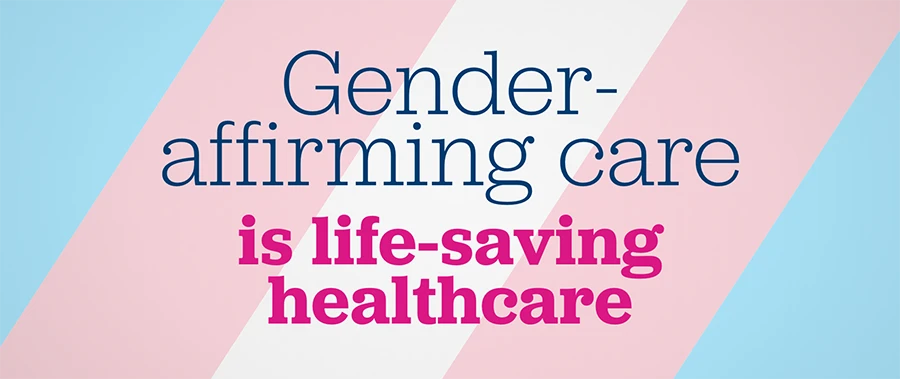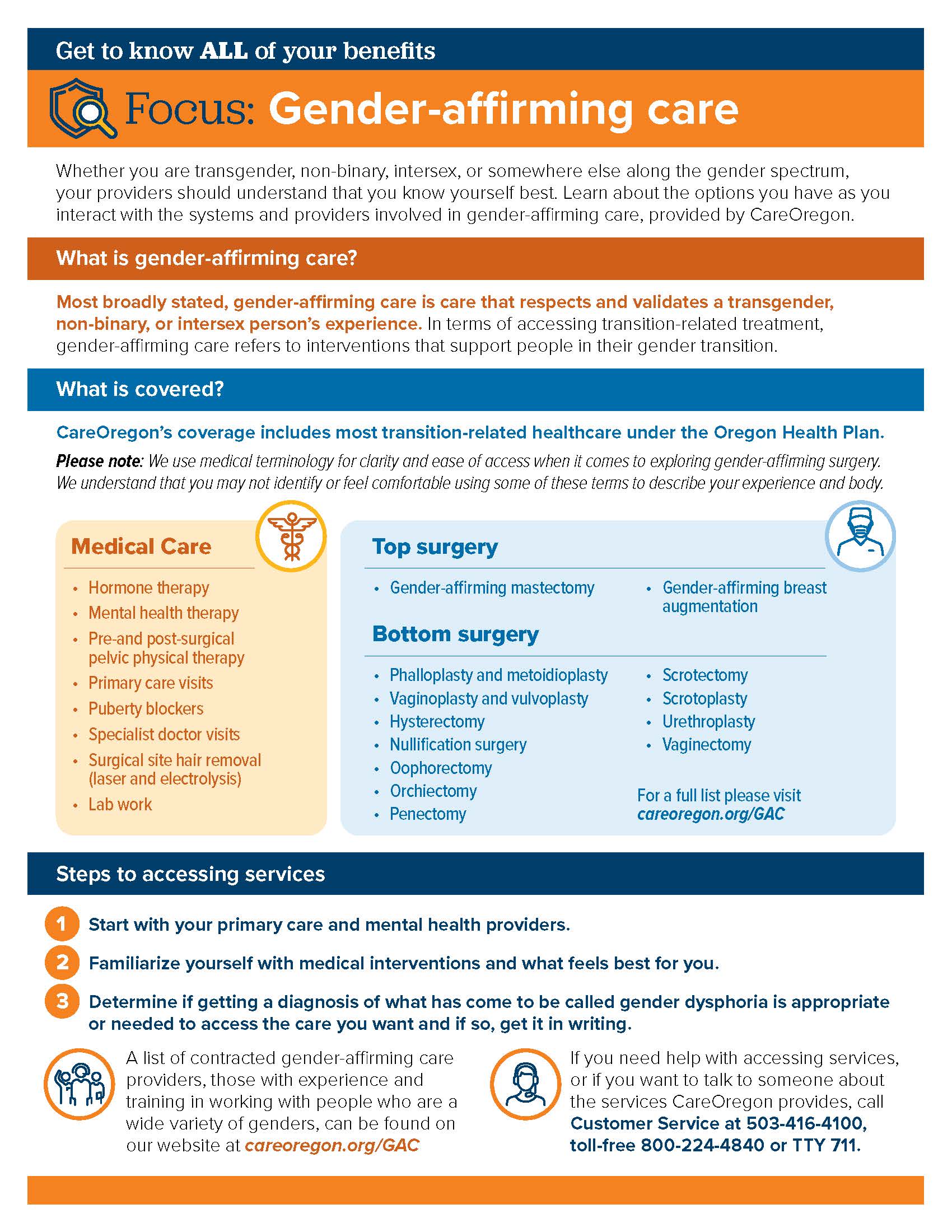
Whether you are working with a member who is transgender, non-binary, intersex, or somewhere else along the gender spectrum, CareOregon is here to assist care providers in supporting their clients access to gender-affirming care.
Please note: We use medical terminology for clarity and ease of access when it comes to exploring gender-affirming surgery. We understand that members may not identify or feel comfortable using some of these terms to describe their experiences and bodies.
What is gender-affirming care?
Gender-affirming care is healthcare that helps people feel more comfortable with their gender. Some people might not feel like the gender they were assigned at birth matches who they really are. Gender-affirming care helps them make changes to feel more like themselves. The goal of gender-affirming care is to help people feel happy and safe in their own bodies and be who they really are.
Click on a link below to view our gender-affirming care handout:

What type of gender-affirming care does CareOregon cover?
CareOregon’s coverage includes medically-necessary transition-related healthcare as established by the Oregon Health Plan and Oregon law (ORS 414.769). These services are listed in the dropdown menus below.
Please note: some services may require prior approval. For more information, please see Guideline Note 127 of the Prioritized List.
- Hormone therapy
- Puberty blockers
- Hormone blockers
- Mental health therapy, including letters of support
- Lab work
- Electrolysis
- Laser hair removal*
- Pre-and post-surgical pelvic physical therapy
- Speech therapy
- Medical tattooing*
*If you are a provider interested in offering this service, please contact transhealth@careoregon.org
- Mastectomy & chest reconstruction/reduction
- Breast augmentation & mastopexy
- Urethroplasty
- Penectomy
- Orchiectomy
- Phalloplasty
- Metoidioplasty
- Scrotoplasty
- Penile & testicular implants
- Scrotectomy
- Vulvectomy
- Nullification surgery
- Clitoroplasty
- Vaginectomy
- Vaginoplasty
- Vulvoplasty
- Hysterectomy
- Salpingo-oophorectomy
- Facial gender confirmation/facial feminization surgery
- Tracheal shave
- Body contouring
- Medical tattooing*
- Surgical revisions
*If you are a provider interested in offering this service, please contact transhealth@careoregon.org
Where can members find gender-affirming care?
CareOregon contracts with many licensed behavioral health professionals, primary care doctors, specialists (such as endocrinologists), and surgeons who can provide gender-affirming care.
Gender-affirming care providers, those with experience and training in working with people who are a wide variety of genders, are listed in our gender-affirming care directory.
How can I be added to the gender-affirming care directory?
At this time, all providers must be contracted with CareOregon. If you are a contracted provider that wants to be added to our directory, please fill out the Gender-Affirming Care Directory Addition Request form.
Please note: completing this form does not guarantee that you will be added to the directory.
If you are currently in our directory and need information updated/changed, please send an email to transhealth@careoregon.org
What are the steps to accessing services?
1. Primary care and mental health providers
From initial gender dysphoria diagnosis to accessing hormone therapy, surgery, and other medical care, the role of a primary care or mental health provider is the starting point. In some cases, getting a referral from a PCP or MH provider is required in order to schedule a consult for surgery.
2. Familiarize your patients with medical interventions and what feels best for them
There are a variety of options available when it comes to hormonal and surgical interventions. Some surgeons in our network perform different surgeries and have different techniques they use for each. We recommend that our members contact a surgeon’s office to review surgery types, recovery timelines, considerations and risks, along with any other questions they may have.
3. Determining gender dysphoria diagnosis as appropriate or needed
For some members, getting gender-affirming treatments, like surgeries or electrolysis, may require an assessment and a letter of support. The World Professional Association for Transgender Health (WPATH) has updated guidelines called the Standards of Care for the Health of Transgender and Gender Diverse People, Version 8 (SOC8). These guidelines are used by Oregon's Health Evidence Review Commission and the Oregon Health Authority. SOC8 now says that only one letter is needed for surgery, instead of multiple letters. The letter doesn’t have to come from a mental health provider, but from a healthcare provider who has experience in gender-affirming care.
In the past, a mental health provider had to do an evaluation to diagnose gender dysphoria. Only certain licensed professionals could write these letters for the Oregon Health Plan. Some clinics may still be using the old rules as they adjust to the new guidelines.
For more information on letters of support and assessment criteria, please reference WPATH SOC8.
Additional CareOregon resources for members
CareOregon supports transition needs outside of medical interventions. Through social needs assistance, members can request support for certain items or services that will improve their health, but may not be covered under the Oregon Health Plan. These items and services must be consistent with their treatment plan, as developed by their primary care team or other treatment providers.
Some examples of items that can be requested are:
- gender affirming clothing
- binders
- prosthetics
- costs related to name changes
- gender marker changes
- identity documentation
- and more
For more information and to make a request, please visit our other social needs support webpage.

